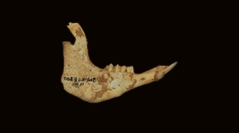

 Comptes Rendus Palevol
10 (5-6) - Pages 469-478
Comptes Rendus Palevol
10 (5-6) - Pages 469-478Hard tissue histology is a valuable tool to reconstruct life history traits in fossil ungulates. We estimated certain fitness components (age at weaning, age at maturity, life span and generation time) in two fossil bovids that evolved under different selective regimes, the insular Myotragus balearicus and the continental Gazella borbonica. Our results provide evidence that the mainland G. borbonica conforms to the predictions for ungulates of similar body size. However, the insular M. balearicus does not fit predictions from body mass scaling, as it shows an important delay in age at weaning and, especially, in age at first reproduction. The considerable differences in the onset of these fitness components reflect the differences in resource availability and in extrinsic mortality that exist between insular and continental ecosystems. The significant delay in life history traits in Myotragus most likely resulted in severe constraints on the ability of this insular mammal to respond to ecological disturbances.
Large herbivores, Paleohistology, Life History, Paleodemography, Insularity, Ecology